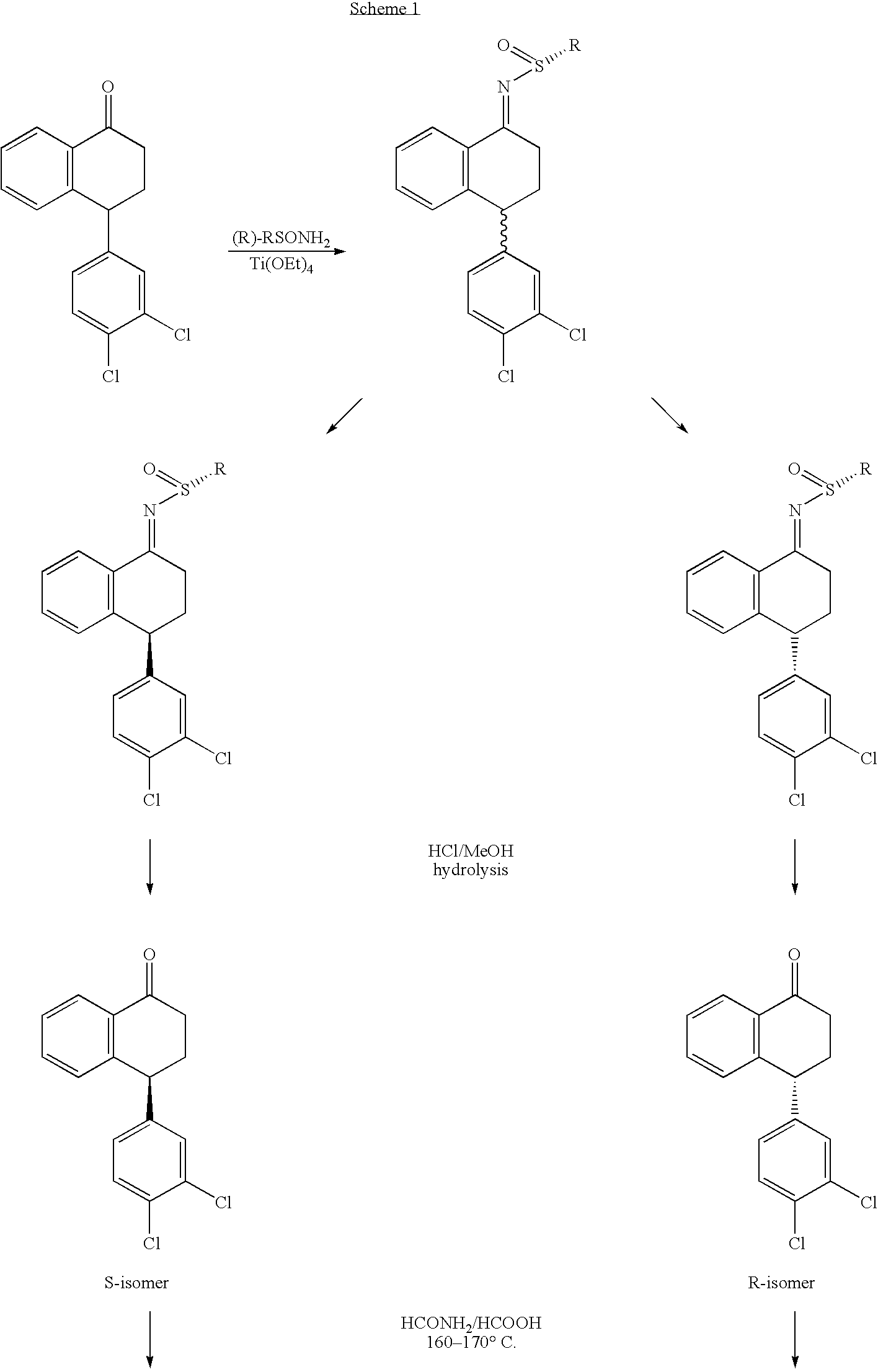TREATMENT OF PAIN DISORDERS WITH trans 4-(3,4-DICHLOROPHENYL)-1,2,3,4-TETRAHYDRO-1-NAPHTHALENAMINE AND ITS FORMAMIDE
- Summary
- Abstract
- Description
- Claims
- Application Information
AI Technical Summary
Benefits of technology
Problems solved by technology
Method used
Image
Examples
example 1
Synthesis of Enantiomerically Enriched Compounds P and Q
1.1 Synthesis of 2-methyl-propane-2-sulfinic acid [4-(3,4-dichlorophenyl)-1,2,3,4-tetrahydro-naphthalen-y-yl]-amide (tetralone t-butanesulfinimine)
[0060]To a solution of 4-((3,4-dichlorophenyl)-3,4-dihydro-1-naphthalene (12 g) in THF (40 mL) was added (R)-t-butanesulfinamide (5.2 g) and Ti(OEt)4 (85 mL 20%) in EtOH. The reaction mixture was heated to 60° C. for 13 h. The reaction mixture was cooled to rt, and poured into a brine solution (100 mL) with stirring. The suspension was then added to EtOAc (300 mL) and stirred for 10 min. The suspension was filtered and the filtrate was concentrated to ca 50 mL. One hundred milliliters of EtOAc was added and the organic phase was separated and concentrated to give a crude reaction mixture. The final products were isolated from the crude products by careful flash column chromatography using EtOAc and hexane (3:7 to 1:1) to give ca 3 g starting ketone, and (1R,4S)-4-(3,4-dichlorophenyl)...
example 2
Radioligand Binding Assays
[0069]Studies were performed to obtain and compare Ki (inhibition constant) values of (1R,4S)-trans 4-(3,4-dichlorophenyl)-1,2,3,4-tetrahydro-1-napthalenamine (Compound P) and sertraline (ZOLOFT™ in radiolabeled binding assays.
[0070]The assays measured the affinity of the two compounds for transporters of the monoamines 5-HT, NE and DA. The assay for affinity to the 5-HT transporter was performed essentially as outlined in Tatsumi M. et al., Eur. J. Pharmacol. 340 249 (1997). The assay for affinity to the NE transporter was performed essentially as outlined in Pacholczyk T. et al., Nature, 350: 350 (1991). The assay for affinity to the DA transporter was performed essentially as outlined in Andersen P. H., J. Neurochem, 48: 1887 (1987). The transporters were human recombinant proteins expressed in mammalian cells. Binding to the 5-HT transporter was assessed by evaluating displacement of [3H]paroxetine (0.1 nM). Binding to the DA transporter was assessed by...
example 3
Functional Uptake Assays
[0072](1R,4S)-trans 4-(3,4-dichlorophenyl)-1,2,3,4-tetrahydro-1-napthalenamine (Compound P), (1S,4R)-trans 4-(3,4-dichlorophenyl)-1,2,3,4-tetrahydro-1-napthalenamine (Compound Q), and a mixture of the two were tested for their ability to inhibit the functional uptake of radiolabeled 5-HT, NE, and DA into synaptosomes prepared from rat whole brain, hypothalamus, or corpus striatum, respectively. The 5-HT and NE assays were performed essentially as outlined in Perovic S. & Müller W. E. G., Arzneim.-Forsch. Drug Res., 45: 1145 (1995). The DA assay was performed essentially as outlined in Janowsky A. et al., Neurochem., 46: 1272 (1986).
[0073]IC50 values (concentration inhibiting control activity by 50%) for Compounds P, Q, a mixture of the two, and some known monoamine reuptake inhibitors are shown in Table 2. Fluoxetine (PROZAC®) IC50 values were taken from Wong et al., Neuropsychopharmacology, Jun, 8(4):337-44 (1993).
TABLE 2IC50 Values (nM) in Functional Uptake...
PUM
| Property | Measurement | Unit |
|---|---|---|
| Fraction | aaaaa | aaaaa |
| Fraction | aaaaa | aaaaa |
| Fraction | aaaaa | aaaaa |
Abstract
Description
Claims
Application Information
 Login to View More
Login to View More - R&D
- Intellectual Property
- Life Sciences
- Materials
- Tech Scout
- Unparalleled Data Quality
- Higher Quality Content
- 60% Fewer Hallucinations
Browse by: Latest US Patents, China's latest patents, Technical Efficacy Thesaurus, Application Domain, Technology Topic, Popular Technical Reports.
© 2025 PatSnap. All rights reserved.Legal|Privacy policy|Modern Slavery Act Transparency Statement|Sitemap|About US| Contact US: help@patsnap.com



